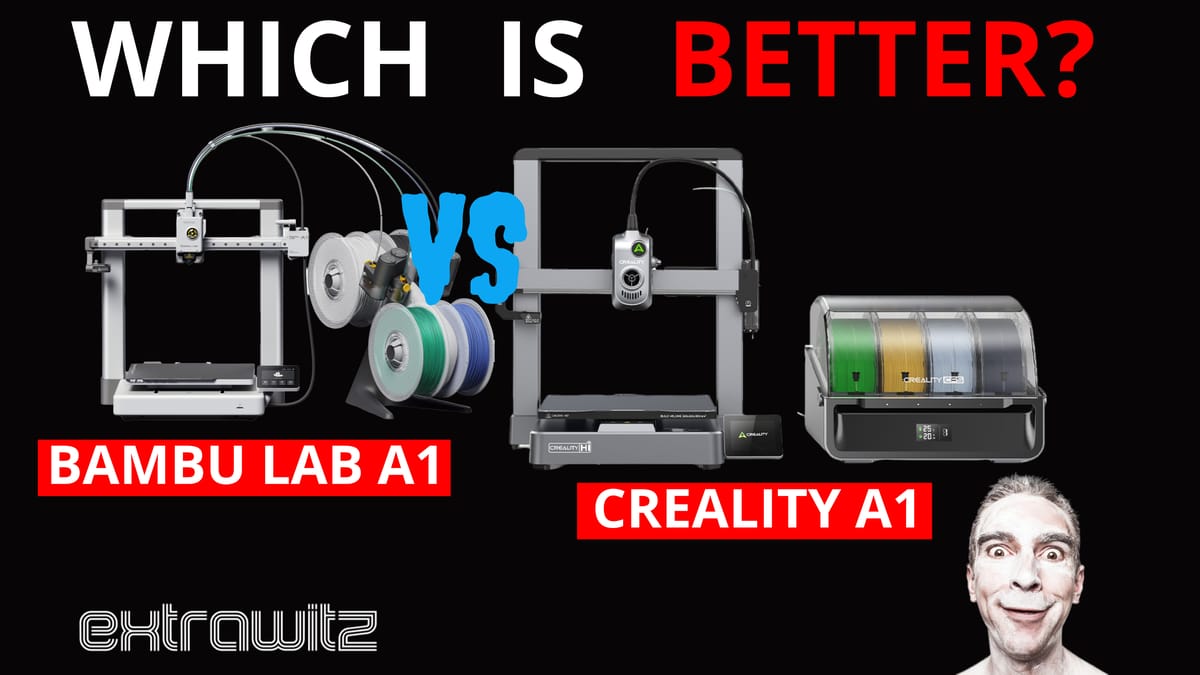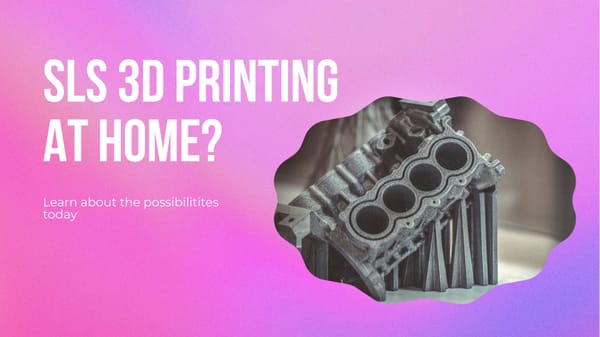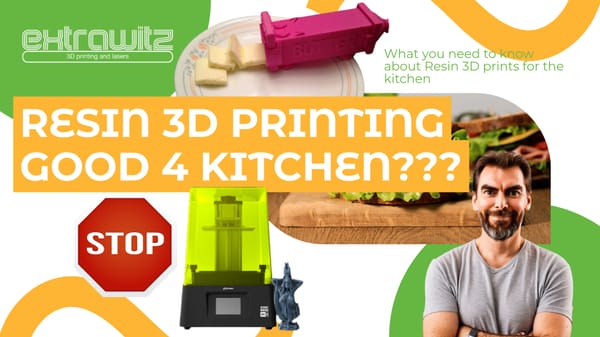Creality Hi Combo vs. Bambu Lab A1 – Multicolor 3D Printing Showdown incoming
Creality unveiled the Hi Combo at CES 2025, a multicolor 3D printer rivaling the Bambu Lab A1. With a larger build volume, support for up to 16 colors, and a $469 price tag, it’s ideal for scalability. Meanwhile, the A1 Combo excels in ease of use with its plug-and-play setup and AMS Lite system.

Creality Hi Combo vs. Bambu Lab A1: Multicolor 3D Printing Showdown at CES 2025
The world of 3D printing just got more exciting with Creality's announcement of the Creality Hi and Hi Combo at CES 2025. Designed to compete directly with the popular Bambu Lab A1, the Creality Hi aims to deliver advanced multicolor printing features at a more affordable price point.
With its larger build volume, scalable filament system, and competitive pricing, the Creality Hi Combo is poised to shake up the entry-level multicolor 3D printing market. But how does it stack up against the Bambu Lab A1, a favorite among hobbyists and professionals alike? Let’s dive into the details to see how these two printers compare.

Key Features of the Creality Hi Combo
The Creality Hi Combo brings a host of impressive features that make it a strong contender in the multicolor 3D printing space. At its core, the printer is designed for affordability and versatility, offering advanced capabilities typically found in higher-priced models.
- Affordable Pricing: The Creality Hi standalone model starts at $299, while the Hi Combo, which includes the Creality Filament System (CFS), is priced at $469—undercutting its main competitor, the Bambu Lab A1 Combo, by $80.
- Generous Build Volume: With dimensions of 260 x 260 x 300 mm, the Creality Hi provides a taller build area compared to its rivals, making it ideal for larger prints. At least somewhat taller 😆
- Pre-Assembly for Convenience: The printer ships 95% pre-assembled, reducing setup time and making it accessible even for beginners.
- High-Speed Printing: Capable of printing at speeds up to 500 mm/s with acceleration reaching 12,000 mm/s², it ensures faster print times without compromising quality.
- Advanced Features:
- A direct-drive extruder with metal gears for reliable filament handling.
- Hands-off calibration with auto-leveling and input shaping for smoother prints.
- A built-in camera with a privacy shutter for remote monitoring.
- Wi-Fi connectivity for seamless wireless printing.
These features make the Creality Hi Combo not only a powerful tool for hobbyists but also a viable option for professionals seeking an affordable multicolor solution.
Key Features of the Bambu Lab A1
The Bambu Lab A1 has earned its reputation as a reliable and user-friendly 3D printer, particularly for those new to multicolor printing. With its streamlined design and robust ecosystem, it offers a plug-and-play experience that sets it apart in the market.
- Competitive Pricing: The base Bambu Lab A1 model is priced at $339, while the A1 Combo, which includes the AMS Lite system for multicolor printing, is available for $499.
- Compact Build Volume: With dimensions of 256 x 256 x 256 mm, the A1 provides ample space for most projects, though slightly smaller than the Creality Hi.
- Plug-and-Play Setup: The printer is designed for ease of use, featuring full-auto calibration that eliminates the need for manual adjustments.
- High-Speed Printing: Like the Creality Hi, the Bambu Lab A1 supports speeds up to 500 mm/s, with acceleration reaching 10,000 mm/s² for efficient print times.
- Advanced Features:
- The AMS Lite system enables multicolor printing with up to four colors, offering a compact and reliable solution.
- Active flow rate compensation ensures precise extrusion for high-quality prints.
- Silent operation under 48 dB thanks to active motor noise canceling.
- An all-metal hotend capable of reaching temperatures up to 300°C, supporting a wide range of filament types.

The Bambu Lab A1 excels in providing a seamless user experience, making it an excellent choice for beginners or those seeking reliable performance without extensive setup or maintenance.
Multicolor Printing Comparison

One of the standout features of both the Creality Hi Combo and the Bambu Lab A1 Combo is their ability to handle multicolor printing. However, the two printers take very different approaches to this capability, with Creality focusing on scalability and Bambu Lab emphasizing simplicity.
| Feature | Creality Hi Combo | Bambu Lab A1 Combo |
|---|---|---|
| Multicolor Capability | Up to 16 colors (via CFS) | Up to 4 colors (via AMS Lite) |
| Filament System Design | Modular and daisy-chainable units for scalability | Compact, integrated AMS Lite system |
| Ease of Maintenance | Simplified servicing for user convenience | Reliable but part of a closed ecosystem |
The Creality Hi Combo shines with its Creality Filament System (CFS), which allows users to daisy-chain up to four units for a total of 16 colors. This makes it an ideal choice for projects requiring extensive color variety. In contrast, the Bambu Lab A1 Combo uses the AMS Lite system, which supports up to four colors in a compact, integrated design. While less scalable, the AMS Lite is highly reliable and easy to use, making it perfect for straightforward multicolor printing tasks.
Ultimately, the choice between these two systems depends on your specific needs: if you value scalability and flexibility, the Creality Hi Combo is the better option. If you prioritize simplicity and reliability, the Bambu Lab A1 Combo may be more suitable.
Build and Design Comparison
Both the Creality Hi Combo and the Bambu Lab A1 boast robust designs, but they cater to slightly different user preferences in terms of build volume, materials, and assembly.
| Feature | Creality Hi Combo | Bambu Lab A1 |
|---|---|---|
| Build Volume | 260 x 260 x 300 mm | 256 x 256 x 256 mm |
| Frame Material | All-metal chassis (die-cast aluminum alloy) | Aluminum and steel |
| Pre-Assembly | 95% pre-assembled | Fully plug-and-play |
| Noise Level | Not specified | Silent mode under 48 dB |
The Creality Hi Combo offers a slightly larger build volume, making it ideal for taller prints or larger projects. Its all-metal chassis provides durability and a professional look, reflecting Creality's efforts to elevate their product quality. The printer ships 95% pre-assembled, requiring minimal setup effort.
On the other hand, the Bambu Lab A1 is designed for maximum convenience with a fully plug-and-play setup. While its build volume is slightly smaller, it is sufficient for most standard projects. Additionally, the A1 excels in quiet operation, running at under 48 dB in silent mode, which is a significant advantage for users working in shared or quiet environments.
Both printers are thoughtfully designed, but the Creality Hi Combo prioritizes build volume and scalability, while the Bambu Lab A1 focuses on user convenience and noise reduction.
Performance and Usability
When it comes to performance, both the Creality Hi Combo and Bambu Lab A1 deliver high-speed printing and advanced features, but they cater to slightly different user needs in terms of usability and precision.
- Printing Speed: Both printers are capable of speeds up to 500 mm/s. However, the Creality Hi Combo edges ahead with higher acceleration at 12,000 mm/s² compared to the A1's 10,000 mm/s², enabling slightly faster transitions during prints.
- Calibration and Setup:
- The Bambu Lab A1 is designed for ease of use with full-auto calibration, making it ideal for beginners or those looking for a hands-off experience.
- The Creality Hi Combo also offers hands-off calibration with auto-leveling and input shaping but requires minimal setup due to its 95% pre-assembled design.
- Software Integration:
- The Bambu Lab A1 integrates seamlessly with Bambu Studio and the Handy app, providing an intuitive interface for managing prints and monitoring progress remotely.
- The Creality Hi Combo includes Wi-Fi connectivity and a built-in camera with a privacy shutter for remote monitoring, offering flexibility for users who prefer open-source software or custom workflows.
While both printers are highly capable, the Bambu Lab A1 excels in user-friendliness with its plug-and-play setup and intuitive software ecosystem. Meanwhile, the Creality Hi Combo stands out for its slightly faster performance and larger build volume, making it a better choice for users who prioritize scalability and speed.
Why Choose Each Printer?
Both the Creality Hi Combo and Bambu Lab A1 Combo bring unique strengths to the table, making them appealing to different types of users. Here's a breakdown of why you might choose one over the other:
Why Choose the Creality Hi Combo?
- Scalability: With the ability to daisy-chain up to four CFS units, the Creality Hi Combo supports up to 16 colors, making it ideal for projects requiring extensive multicolor printing.
- Larger Build Volume: Its 260 x 260 x 300 mm build area is perfect for taller or larger prints, offering more flexibility for creative projects.
- Affordability: At $469 for the combo package, it provides excellent value for its advanced features, undercutting the Bambu Lab A1 Combo by $30.
- Advanced Features: High-speed printing with 12,000 mm/s² acceleration, Wi-Fi connectivity, and a built-in camera make it a powerful tool for professionals and hobbyists alike.
Why Choose the Bambu Lab A1 Combo?
- Ease of Use: With full-auto calibration and a plug-and-play setup, the A1 Combo is perfect for beginners or users who want minimal setup and maintenance.
- Reliable Multicolor Printing: The AMS Lite system supports up to four colors in a compact, integrated design that’s easy to use and highly dependable.
- Quiet Operation: Running at under 48 dB in silent mode, it’s an excellent choice for users in shared or quiet environments.
- Software Ecosystem: Seamless integration with Bambu Studio and Handy app provides an intuitive and polished user experience.
Ultimately, the choice between these two printers depends on your specific needs. If you prioritize scalability, affordability, and larger (higher) build volume, the Creality Hi Combo is an excellent option. On the other hand, if you value ease of use, reliability, and a quieter operation, the Bambu Lab A1 Combo might be the better fit.




